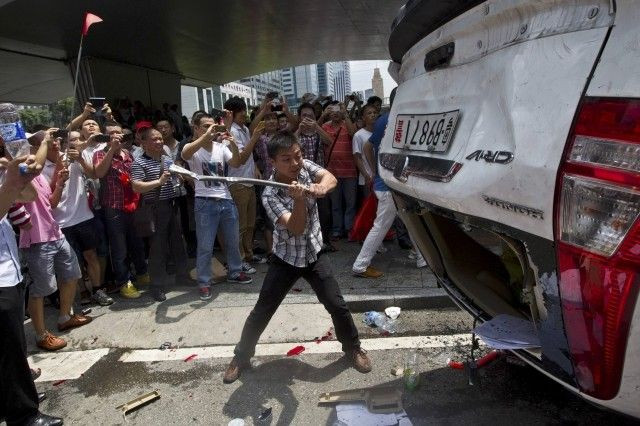China And Japan Fail To Ease Tensions After Japanese Nationalists Visit Disputed Islands

Anti-Japan protests erupted in the major Chinese cities of Guangzhou, Shenzhen, Shenyang, Hangzhou, Harbin, Qingdao, and elsewhere across the country on Sunday.
In response to landings made by Japanese ultra-nationalists on the Senkaku/Diaoyu Islands, Chinese citizens turned out to show their ire -- in some cases attacking Japanese stores and products. The turnout is expected to be the largest since major diplomatic and territorial disputes between the two countries in 2005 led to widespread demonstrations in China and expanded into broader trade battles.
Ten Japanese nationalist activists swam ashore from a fleet of 20 vessels sailing near the islands on Sunday. Tokyo refers to them as the Senkakus -- Beijing and Taipei call them the Diaoyu Islands. Disputed ownership of the eight islets can be traced back to the end of World War II. China (and Taiwan) claim that sovereignty was returned after the war; Japan says the post-war redrawing of borders in Asia did not include the tiny archipelago.
The characters used to represent the main island of the group, Uotsuri-jima (Japan) or Diaoyu Dao (China), are in fact written the same way in both languages, and only have negligible differences in ordering.
The 10 activists who swam onto Uotsuri/Diaoyu on Sunday morning (Tokyo time), unfurled Japanese flags, and then returned to their boats. The Japanese coast guard called the action unsanctioned, and warned the group to depart, but did not take action to arrest or reprimand the group.
On Wednesday, a group of Chinese 14 nationalists from Hong Kong were arrested for illegally entering Japanese territory when traveling to the islands. Seven made the trip ashore, the first time since 2004 that non-Japanese have set foot on the area. The group carried both the red and yellow starred flag of the People's Republic of China and the blue-backed white sun flag of the Republic of China (Taiwan) onto Uotsuri/Diaoyu.
The Hong Kong group, known as the "Action Committee for Defending the Diaoyu Islands," says that its trip was aimed at pre-empting the Japanese who landed on Sunday.
Tokyo originally attempted to deflate tensions with China by quickly deporting the 14 back to Hong Kong on Friday. That move now seems far less effective in light of the Japanese nationalists' activities.
Beijing warned on Saturday that "any unilateral action taken by Japan on the islands is illegal and invalid."
On Friday, Taipei chimed in to say, "It is in keeping with our government's territorial claim that the national flag of the Republic of China was on the Diaoyu islands, which Japan is furtively occupying."
The flotilla of 20 Japanese vessels were carrying the activists to honor the country's war dead, as well as right-wing parliamentarians and regional politicians looking to showcase their nationalistic credentials.
The Associated Press quoted Koichi Mukoyama, one of seven Japanese Diet members on the ships, who said that Japan needed "to solidly reaffirm our own territory," due to the earlier landing of the Chinese nationalists.
Seiji Maehara, a former Japanese foreign minister and now policy chief for the governing Democratic Party of Japan, urged further resources for the coast guard and defenses for the disputed islands. "We should discuss not only [increasing] the number of staff and ships but also possibilities of various other supports [to the coast guard]," said Maehara.
China's foreign ministry said on Sunday, "The Japanese side should properly handle the current issue and avoid seriously damaging the overall situation of China-Japan relations."
© Copyright IBTimes 2025. All rights reserved.




















